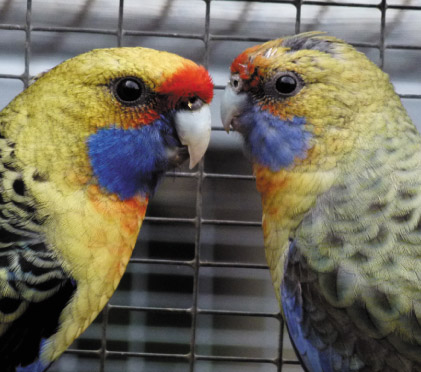 1
1
I was hoping to present a full rundown on the successful breeding of the yellow rosella Platycercus flaveolus in this edition of Talking Birds.
By rundown I mean commencing with young birds through to their maturity, successful breeding and finally young that they produced flying in the aviary with the parents.
Due to circumstances beyond my control the last segment is yet to occur and the best I can do at this time is to present the progress through to the stage of young being produced, when I was forced to take over and am handrearing two young ones.
Let me begin with this following heading:
I mentioned in a previous edition of Talking Birds that the yellow rosella was just one of the extensive rosella group that I had not bred.
In the early stages of my extensive period of time keeping Australian and exotic parrot-type birds I did have a pair of yellow rosellas for a reasonable time. I was not successful in breeding them and observed that the male was continually aggressive towards his partner.
There were other things that interested me at the time and due to the aggressive nature of the male I finally decided to part with the pair. Hindsight is a wonderful thing and with the experience that I have since gained there were other courses of action that I could have taken but did not. One would have been to dispose of one of that particular pair and look for replacements.
What readers need to appreciate is at that time I was not aware of many yellows in Western Australia. I did not have many contacts in other states who could supply the required bird/s, surgical sexing was not available and neither was DNA testing.
All of those factors have now changed significantly and I am now in a much better situation to address those issues.
In producing articles for this magazine in the main I use topics based on stock I keep or have kept plus my own observations and experiences. Naturally there is a limit to the number of parrot- type species that I have kept and keep now.
Well, I had just about run out of additional species to inform readers of and I made the decision to obtain a couple of other species to discuss. The yellow rosella was one that came to mind.
Obtain more young birds than you need, prove the sexes, allow them to select their own partners. I am of the opinion that there is a most practical approach to the selection of parrot-type birds if you have the objective of producing offspring in mind.
If you are happy to select a species based on colour and/or behaviour that is an entirely different subject.
The practical approach for the individual contemplating keeping and breeding has considerable drawbacks that one has to appreciate. Confronting you is cost, availability of stock and space where you intend keeping them.
In the case of the large rosellas they should be one pair to an aviary.
As this was an exercise in keeping/breeding, observing and logging details throughout the project would one pair be sufficient?
I considered a single pair unsatisfactory, a better proposition would be to start with at least two pairs. Should you start with just one pair you cannot guarantee that what you purchase will like each other and breed for you? Increasing the number of pairs increases your chances, a bit like buying Lotto tickets.
At the end of the day you can implement all of the previous steps I listed but you are finally left with that indeterminate "nature taking its course".
In 2012 I was very pleased that an avicultural friend in New South Wales sourced a number of young yellows for me that had been bred in 2011.
I was starting with all young birds which is the first step that I advise. They duly arrived by air with all the required paperwork and any air freight is an exorbitant expense. A monopoly is never a good proposition for the consumer.
Definitely not straight out into the aviaries at any old time like I know many birds do at other locations.
New arrivals at my place go up to the shed in holding pens. Water plus a range of seed and soft foods is provided and the interior lights are left on day and night to provide the maximum settling in period.
With newspaper on the floor of the pens I can check the condition of faeces which can indicate tummy troubles and/or a lack of eating solids. At the same time I monitor the consumption of seed, water and soft food.
Once they are eating and drinking they are drenched for intestinal worms and dusted for surface vermin.
The method used was DNA testing using a blood sample taken from above the toenail.
With the results of the DNA tests I had sufficient birds to make up two true pairs with some extras.
Some members of the rosella family can be visually sexed but the results are variable based on the variations between individuals.
In the case of pair 2 — the yellows with orange suffusion — the difference in sex is significant. The male has a much more pronounced head and beak size, see photo 1, male on the left.
In the various sub-species of the rosella that I have kept — northern, crimson, green, blue cheeked, eastern and now the yellow — the male has a head that is flatter while the females head appears more rounded.
In smaller rosellas such as northern and western the beak and head shape is not as markedly obvious. Blacker head colour in the northerns can be a slight indicator while in the western there are striking differences in body colour between sexes.
Generally the male rosella is a larger bird with body and cheek patches more brightly coloured.
After their quarantine settling in period of roughly a fortnight — more time if you have any doubts — all the rosellas were placed in one aviary.
In the yellows I have seen some young show a light orange wash/suffusion to feathers in the front of the throat and upper chest. Some may lose that suffusion as they mature.
I prefer birds that do not show that orange, see male photo 2. I went ahead and did what I advise others against — I made the selection of a true pair that did not show any orange, I call them pair 1.
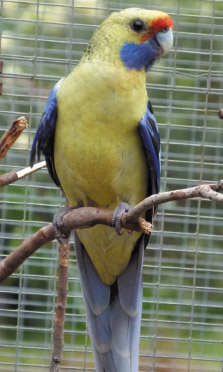 2
2
I allowed all others to remain together and finally identified two others — that did have some orange — which sat together and appeared bonded, that is pair 2. I had higher hopes for pair 2 because they were buddies and not a forced partnership.
Pairs 1 and 2 are located in a bank of 20 aviaries with a safety access corridor along the front providing service facilities as well as an additional exercise area.
Aviaries face east-west, east for the morning sun and the west end is completely enclosed for roughly a third of the length of the aviary to provide protection from wind and rain. All aviaries are double wired to prevent injuries to birds in adjoining aviaries.
In the aviaries either side of pair 1 are a pair of Port Lincolns and a pair of Derbyan parakeets and on one side of pair 2 is an aviary of odds and sods weirdos and on the other side a pair of twenty-eights.
Each aviary is 4.5m long x 1.2m wide x 2m high. The covered area has two nest boxes mounted in it. Two perches run across the width inside the covered area and there are one or two seed hoppers, each sufficient to hold enough seed for two parrots for roughly a month.
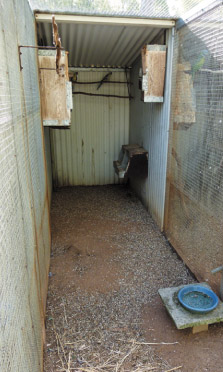 3
3
Out in the open area a perch runs along the length and there is a glazed dish for water, see photo 3.
There is one solid pine plank nest box, internally 150mm square by 450mm deep. The nest has a entrance hole 55mm in diameter and the box is mounted on the north wall, see photo 4. The entrance to the box is facing north.
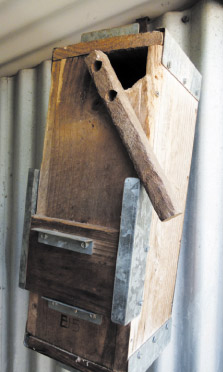 4
4
There is another box 200mm square by 600mm deep, the entrance is a round hole 60mm diameter. This larger box is mounted on the south wall with the entrance to the box facing south. Pair 1 has an additional hollow log on the south wall.
A dry seed mix of grey-stripe sunflower, hulled oats, plain canary and French white millet is in the hopper.
A mesh tray is near the service corridor and a wire hook is attached to the door. Fruit — apple, orange, pear etc. Vegetables — silver beet, celery, kale, broccoli, sweet corn on the cob are supplied at different times. Also provided are all manner of natural Aussie tree branches, plus tagasaste (tree lucerne): it is not Australian, but they love it. All those items are placed on the wire tray or stuck on the wire hook.
Seeding grasses were supplied in spring plus cape weed and a range of oats, wheat and barley that the head gardener cultivated and was fed to the birds semi-ripe.
Breeding season 2012. The best looking all-yellow pair I put together did nothing, I never saw the male feeding the female, display, or even lift a leg. I never saw the female going near any of the nests.
Pair 2, the female orange suffused, spent time in the smallest nest box on the northern wall of the covered section. I later found two eggs in the nest but the female did not incubate.
Pair 2, orange suffusion, I never saw any companion feeding or any mating. I found two broken eggs on the ground near the covered area and much later a single egg in the box but it had not been incubated. Failure.
Pair 1, the all yellows, chose the small box on the northern wall and the girl laid five eggs. First egg would have been October 15, female commenced incubation roughly October 21.
Incubation period for these parrots is 21 days. Three chicks hatched, see photo 5. Progressing nicely through very variable weather conditions.
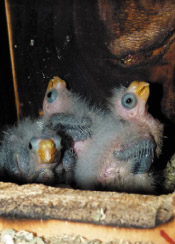 5
5
Calamity, OH NO, I checked the box after some cold nights and one chick had kicked the bucket. This forced my hand, I could not risk losing any others so up to the house they have moved and I am hand-rearing them. Just one more task, at this point in time I need it like a hole in the head.
A striking feature of these lovely little critters is the prominent big dark eyes, see photo 6. Those dark eyes are a feature of many Australian rosella and ringneck parrots such as Port Lincolns and twenty- eights.
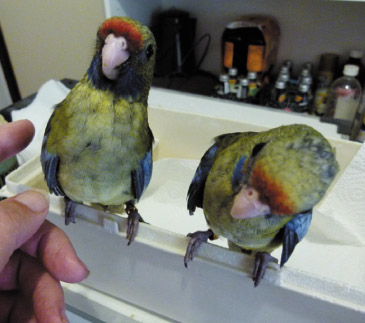 6
6
The little guys are really quiet, they eat well and are now at the stage where they want it, no they don't, yes they do. They are just starting to investigate some small seeds, greens and apple.
While the rosellas I started with were all youngsters I have found all four birds to be flighty, the males I consider nutters. The moment I appear near the aviary off they go from one end to the other.
The Western Australian red cap also has a reputation to be very flighty but if hand-reared when mature they can be delightful. I have hand-reared red cap males that come and take green feed from my hand when they have young in the nest to feed.
When preparing this article I checked the four mature birds for a wing stripe — on some species of Aussie parrots some of the underwing feathers have small areas of white on them — to see if this could be useful for identification.
Both males showed no sign of a wing stripe on any single feather. Both females showed a smidgen of white on a few feathers, I needed to look hard and I consider that in the case of these two females it would be doubtful for a newcomer to the hobby to see and therefore I would not consider it a positive aid.
Other yellow rosellas may show substantial wing stripes. For positive sex identification especially in young birds stick to DNA testing or have surgical sexing performed by a professional.
It is now the latter part of December and I consider summer is with us. We have experienced a run of a number of days of 40C plus and the birds are throwing their wings in the air and indicating they need a spell. Some are starting to moult, those feathers are looking ratty and the bright colours are fading fast.
Well, I did not quite achieve all of my aims but the two youngsters are really steady and looking in good shape. Down the track I will push on to have parent-reared young flying and maybe get around to having some steadier pairs for the future.
In the meantime yellows are not as visually exciting as some of the other rosellas but still an attractive bird to have in your aviary.
This article first appeared in the January 2014 edition of Talking Birds Newsmagazine, Australia's monthly publication for bird keepers.
Every Talking Birds edition contains articles on parrots, finches, budgies and canaries as well as a vet column, a pet bird page, club news and Australia's only comprehensive calendar of bird sales and other avian events, together with news from bird clubs around Australia, avian vet listings and bird club listings.
Fancy pigeons and fancy poultry articles appear every second month and Talking Birds is the only Australian bird publication to publish up-to-date bird news from Australia and around the world as well as information about new/changed legislation, scammers, thieves, smugglers and self-styled do-gooders who try to bring aviculture down.
Talking Birds subscription form can be found at www.talkingbirds.com.au